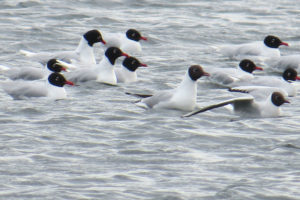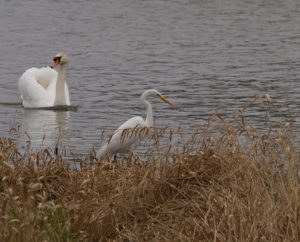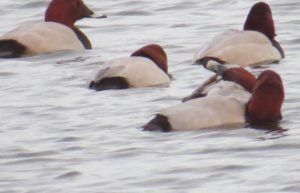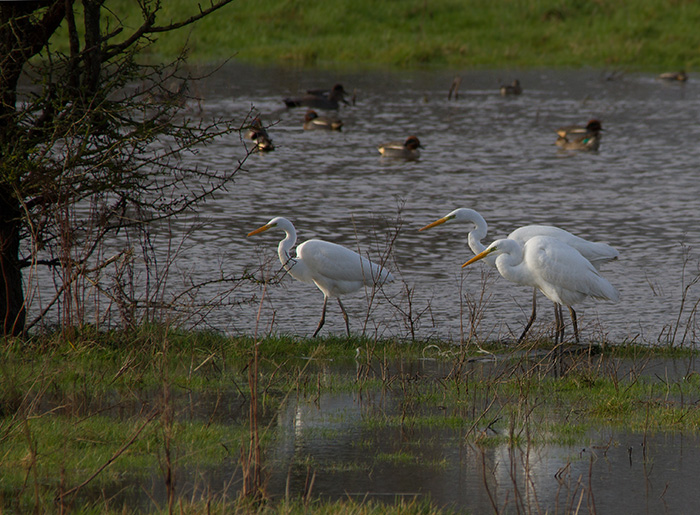30th March
A ringing session this morning produced 3 new birds (2 Blackcaps, 1 Great Tit) and a re-trap Reed Bunting. The latter was ringed in May 2011 so coming up to 6 years – and it was an adult female when ringed, so actually at least (almost) 7 years. The oldest known is almost 10 years so she needs to go on a bit longer yet!

Mediterranean Gulls, Longham Lakes, 30/3/17 (Roger Peart)
As few birds were being caught I had a look at the south lake where by 0830 there was an increase in noise from Mediterranean Gulls on the water. A very large flock had arrived (there were a few earlier on) and I estimate at least 200 birds including some Black-headed Gulls and possibly a few of other spp. So I reckon there were about 150 Med Gulls. The single Great White Egret was still present, and a pair of Shoveler. At about 10am just before I left there were at least 10 Sand Martins darting around – difficult to count exactly as they fly so quickly and one isn’t quite sure if they are the same or different (Roger Peart.)
28th March
I had the nets open this evening while putting them up and caught 2 new birds (Wren and Chiffchaff) and five retraps (3 Long-tailed Tits, 1 Robin and 1 Chiffchaff). The Chiff was ringed in Sep 2015 and I caught it again last summer so it is a ‘local’ bird! One LTT was ringed in Sep 2012, a nice old bird but only half the age of the oldest known from UK ringing (Roger Peart.)
25th March
Very pleasant this morning with singing Song Thrush, Chiffchaff and 4 Cetti’s Warblers, Dunnocks busy chasing each other and Wren blasting out its loud song. The 2 Great White Egrets were on the large island in South Lake, 4 Sand Martins over North Lake, two pairs of Great Crested Grebes performing their courtship dance, with lots of head shaking with their chestnut frills held wide open but not much else going on. A nice spring sighting of 12 Mallard ducklings by the slipway (Martin Wood.)
19th March
No sign of any Sand Martins today, but I did hear and see a Cetti’s Warbler dashing for cover and found the long staying Great White Egret. I counted around 8 Reed Buntings, the most I’ve seen at Longham, as well as around 60 Mediterranean Gulls on the south lake. There were around 37 Mute Swans in the back fields, three Redwings (no Fieldfares alas) and a small group of Teal were on the small pond past the woods with five Little Egrets. The most notable bird for me was a female Bullfinch which I found in the far corner of north lake by the stile (Darran Jones.)
18th March
Had a very good morning at the lake. The long staying Great White Egret was on the large island in south lake with two Little Egrets. The wintering duck have departed as no sign of any Pochard or Wigeon only 3 Shoveler and 6 Teal and 6 Gadwall. Also singing Chiffchaffs, calling Cetti’s Warblers, c20 Sand Martin and a wonderful sight and sound of 103 Mediterranean Gulls settled on South Lake. It looks like the farmer of Hampreston fields has been busy cleaning out the ditch and cutting some willow down along the ditch and on the river (Martin Wood.) Also 1 Raven in the afternoon, and several Sand Martins still (Dominic Couzens).
No sign of the Sand Martins that Martin saw on the 18th, but I did hear and see a Cetti’s Warbler dashing for cover and found the long staying Grea -White Egret. I counted around 8 Reed Buntings, the most I’ve seen at Longham, as well as around 60 Mediterranean Gulls on the south lake. There were around 37 Mute Swans in the back fields, three Redwings (no Fieldfares alas) and a small group of Teal were on the small pond past the woods with five Little Egrets. The most notable bird for me was a female Bullfinch which I found in the far corner of north lake by the stile (Darran Jones).
17th March
Redshank on island in South Lake. Also a small influx of 10+ Sand Martins plus 72+ Mediterranean Gulls – my first high count of the spring (George Green.)
14th March
One Great White Egret still present perched in tree at south end of South Lake (George Green).
11th March
It was a nice walk round the lakes with birds singing and calling. Those Bullfinches are still eluding me; I looked all round the hedges of North lake. There were Reed Buntings, Goldfinches, Long tailed Tits and Cetti’s Warblers. Out of the thicket shot a male Sparrowhawk that flew low right over the top of me – a wonderful sighting. Two Great White Egrets were on the Stour, while out on South Lake, 9 Pochard still remain but numbers going down; with them 16 Wigeon, 9 Teal, 2 Shoveler and 6 Gadwall, plus Mallards, Tufted Duck and Coot. Looking through the gulls I had 1 Common Gull, 4 Lesser Black-backed Gulls, 1 Great Black-backed Gull and 11 Mediterranean Gulls mixed in with the Black-headed Gulls. Besides all of these there were the usual woodland species like Blue Tits, Great Tits, Chiffchaff, Green Woodpecker a Kestrel and a new bird for the Patch Work Challenge: a pair of Jays which brings the years patch list up to 70 species of bird and 4 mammals seen so far (Martin Wood.)
8th March
News of a local ringing recovery today:
Blackbird LA58296 N
3JF 07/07/14 AMT Longham Lakes East (5), Dorset
X 0F Dead 07/03/17 Bournemouth Airport, Dorset (5 km, E, 2 yrs 243 days)
4th March
At the lakes late afternoon 2 Great White Egrets on the River Stour. 20 Little Grebe, 36 Mediterranean Gull, a Kestrel plus a Sparrowhawk seen. Also 12 Pochard in the south west corner of south lake, in the flooded pools in Hampreston Fields: 14 Wigeon, 7 Gadwall, 10 Teal and a pair of Shoveler (Martin Wood).
2nd March
Today’s best bird wasn’t a bird. Actually, you couldn’t really describe it as a “best” sighting either, because it was an American Mink. It was only my second sighting of this sleek mammal here at Longham, so I couldn’t help but be pleased. On the other hand, Minks are bad news for many native animals. It cut across the path next to Emily’s Wood, paused while we looked at each other, and slunk away. There were also 4 Roe Deer on-site, in two sets of two.
Bird-wise today was quite average, excepting that one Great Egret remains. There were also plenty of wildfowl, including all the winter ducks such as Gadwall, Teal, Wigeon and Shoveler. Gulls included a second-winter Mediterranean Gull and three Great Black-backed Gulls, 2 adults and a first-winter. 2 Stonechats, a male and a female, were beside the reservoirs, and 40 Greylag Geese made as much noise as you would expect 40 geese to make. The many ringing calls around the site show that at least two pairs of Green Woodpeckers are holding territory. The level of song is increasing delightfully.
I had an interesting Pheasant encounter on the West Fields (not accessible to the public). I flushed one, then two more, one and another two Pheasants, making six in all, a record for Longham Lakes. One of these birds was a male, and all the rest females, so there is one happy bird out there all set for a lively breeding season (Dominic Couzens.)
1st March
I had literally 15 minutes to look over the lakes this afternoon, but it was well worth it. A male and a female Goosander were fast asleep out on Longham Reservoir South, unaware that they were my 72nd species for the year (Dominic Couzens).
26th February
At first the lakes looked devoid of any birds besides a few Coot and Tufted Duck in the very choppy water. But looking carefully on the causeway there were 3 Stonechat, a couple of Reed Buntings and 32 Pied Wagtails. On the river the Great White Egret was fishing and in the fields were 54 Canada Geese and 38 Greylags which took flight and landed on the south lake. I had my 1st patch record of a male Goosander, which I presume it took off while I was watching the geese fly in. Up at the top end of south lake mixed in with the Black-headed Gull were 5 Mediterranean Gulls, and while up at this end I watch 23 Shovelers fly in and land on the lake (Martin Wood).
24th February
Dropped in to the lakes on the way home from work this afternoon. The best finds were 2 Great White Egrets (possibly three), 26 Pied Wagtails in the horse paddocks by the visitor centre, a Cetti’s Warbler and a Mediterranean Gull. And no Bullfinches! (Martin Wood).

Great Egret, River Stour at Longham Lakes, 21/2/17 (Lorne Bissell).
21st February
A visit to the lakes produced 2 Med Gull, 2 Great White Egret and good numbers of all the common ducks (except no Wigeon). A pair of Bullfinches were seen in the hedge south of the visitor centre. A single Lapwing was also present with a pair of Stonechat on the island (Daniel Whitelegg).
20th February
A drake Goosander showed well on the South Lake this afternoon. Much to my surprise this is my first sighting on the actual lakes since winter 2011/2012. All subsequent records have been the from nearby River Stour. Oh yes! A Great White Egret was still present on Hampreston Meadows. Also first sign of Med Gull spring passage with 4 birds present (George Green).
18th February
How about a nice surprise when you are looking through the scope on a sunny day? I was scanning the fields from the west bank looking towards the River when one of the Great White Egrets flew up from the river and head up river. Then something caught my eye moving in the undergrowth, can it be, no it is, I could hardly believe my eyes as the creature emerged from the undergrowth with a lovely sleek brown coat and ambled a long the bank. It was an Otter no less, but in my excitement and just overwhelmed to be watching it through my scope I forgot about grabbing a record shot. This was the first one I have seen from the Longham Patch. Also 15 Shoveler, 30 Teal, about 46 Pochard, 91 Tufted Ducks, 3 Buzzard over, 5 Med Gulls and, a new bird for the Patch Work Challenge this year, a Cetti’s Warbler. Two Great Crested Grebes were performing their courtship weed dance yesterday and today, the first time I have seen this happen. An absolutely wonderful afternoon (Martin Wood.)
17th February
Out on the lake 12 Pochard, some Tuftys and a pair of Great Crested Grebes attempting, half heartily it seemed, a weed dance. Making my way up to the causeway, the Great White Egret flew from the island in South Lake and landed in one of the pools on Hampreston fields. I scanned the island from the west side of South Lake and had a nice surprise with a Water Rail showing well and feeding along the edge of the island until some people started flying there boat plane , which also flushed 11 Lapwings from one side of the island to the other. 20 Shoveler near the western shore made for a very enjoyable sight with the colour of the males and the drab females and the long bills. Song Thrushes, Dunnock and Robins singing made a very pleasant and relaxing walk round the lakes after work (Martin Wood.)
14th February
Valentine’s Day saw me getting up early for two things: flowers for the wife and a chance to spot the Fieldfares that had been spotted by Martin at Longham Lakes. I headed right over to the usual spot, spying one lone Great White Egret, around 21 Pochard and a small group of Tufted Ducks and Great Crested Grebes, but very little else. I found my new birds over the far side of South Lake but I really had to work for them. Martin had already seen some Mediterranean Gulls, so I scoured the large group of gulls that were floating around and causing a ruckus. I counted 127 Black-Headed Gulls, two of which were Mediterraneans, Success! (Darran Jones.)
11th February
A very cold walk round the lakes this afternoon produced newbirds for the Patch Work Challenge and Longham year list, with Fieldfare, Pheasant, Kingfisher and Goldcrest. Also 2 Great Egrets, 27 Greylag Geese, 44 Pochard and 3 Wigeon. Some other counts: Canada Goose – 4, Wigeon – 3, Gadwall, Teal – 16, Shoveler – 15, Pochard – 44, Pheasant – 1 male, Little Egret – 1, Grey Heron – 1, Little Grebe – 16, Moorhen – 2, Common Gull – 1, Lesser Black backed Gull – 3, Collared Dove – 2, Kingfisher –1, Green Woodpecker – 1, Goldcrest – 2, Blackbird – 3, Fieldfare – 20, Redwing – 30, Grey Wagtail – 1 (Martin Wood.)

Pochards, Longham Lakes, 2/2/17 (Roger Peart)
4th February
At Longham Lakes, the water level was down on the large lake, exposing large areas of shore line of the island and sides. As I walked up to the slip way I could hear Wigeon calling, but was not expecting to see a large raft of them – to my surprise there were 152, and another 4 out on the flooded meadows; also 6 Pintail. I also heard a Water Rail at the south east corner down by the river (Martin Wood.)
3rd February
I had a brief visit to Longham this morning before the rain arrived. The three Great White Egrets were still around – all of them initially spread out along the north bank of the north lake. At least a couple of hundred (I guess) Canada Geese on the flooded Hampreston fields, plus some Shovelers and at least 6 Pintail – presumably from the group that arrived a week or so ago. There may have been more than 6 but that is all I could pick out (Roger Peart.)
Totals: Canada Goose 150+ Some by large island but most on flooded fields to the west
Gadwall 4+ By large island on S lake
Pintail 6+ On flooded fields to the west
Shoveler 3+ On flooded fields to the west
Pochard 9+ Party on North lake
Cormorant 4+
Little Egret 2+
Grey Heron 1+ At least one
Great Crested Grebe 2+ on N lake
Buzzard 1 Low over trees to the north
Coot 20+

3 Great Egrets, Longham Lakes, 2/2/17 (Lorne Bissell)
